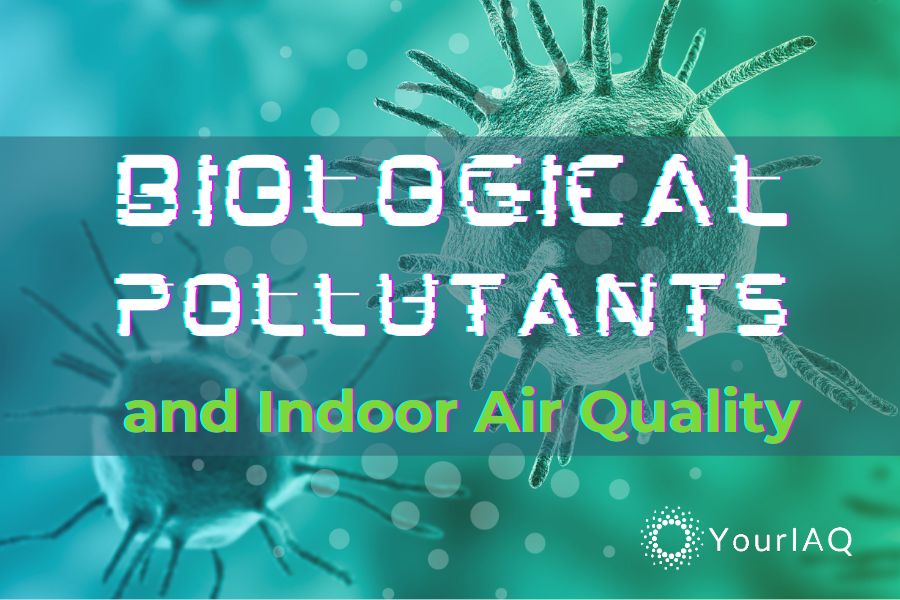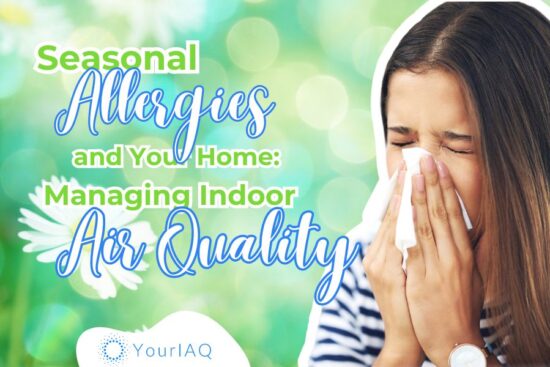
Biological indoor air pollutants, encompassing a broad array of bacteria, viruses, cockroaches, pollen, molds, and more, significantly compromise the quality of the air we breathe indoors.
This is concerning because according to the Environmental Protection Agency, indoor air pollution levels can be 2-5 times higher than outdoors, and most people spend up to 90% of their time inside. Prolonged exposure to bioaerosols, allergens like dust mites and animal dander, and various other sources of biological pollution can negatively impact health.
Given the strong link between these pollutants and indoor air quality, understanding the health effects they can cause and exploring strategies for mitigating exposure is crucial.
This article lists common types and sources of biological indoor air pollutants and their health implications. We will look at how bugs, pests, allergens, pet hair, pollen, mold, and other things can affect the air quality indoors.
What are Biological Pollutants?
Biological pollutants, often referred to as bioaerosols or bio-contaminants, are tiny organisms or their byproducts that adversely affect indoor air quality. These pollutants include things like bacteria, viruses, mold, pollen, and pet dander, and contribute to allergies, respiratory problems, and other health issues.
Bio pollutants are found everywhere and impact health, especially for vulnerable populations. Here are the primary categories, sources, and their health implications:
7 Biological Pollutants and Their Effect on IAQ
Biological contaminants originate from various sources, including plants, humans, and animals. These pollutants grow in indoor spaces in certain conditions, like moisture, warmth, and food sources.
Kitchens, bathrooms, water-damaged materials, poorly maintained appliances, carpets, and even bedding are common areas where these contaminants flourish.
This list examines seven common types, their sources, and how they impact your indoor air quality:
1. Pollen
Pollen, microscopic grains released by plants for reproduction, is a major seasonal allergen. It triggers hay fever symptoms (runny nose, sneezing, itchy eyes) in many individuals, significantly impacting those with allergies.
Common sources: Trees, grasses, and weeds release pollen seasonally. It enters homes through open windows and doors.
Impact on air quality: Even small amounts of pollen worsen allergy symptoms for sensitive individuals, reducing the overall quality of the air they breathe.
2. Pet Dander
Tiny skin flakes animals shed naturally. It contains proteins that act as potent allergens, causing reactions like sneezing, and congestion. Pet dander also makes asthma worse.
Common Sources: Dogs, cats, birds, and other furry or feathered friends naturally shed dander.
Impact on air quality: Pet dander is lightweight and easily becomes airborne, circulating throughout the home. It lingers for extended periods even after the pet has left, effecting IAQ long-term.
3. Bacteria
Single-celled organisms such as bacteria are incredibly diverse. Some are harmless, while others cause illnesses including pneumonia, urinary tract infections, and foodborne illnesses.
Common sources: Bacteria live on humans, animals, in soil, and even on plant debris. Specific illness-causing strains can be associated with certain sources (like Legionella in water systems).
Impact on air quality: The impact depends entirely on the type of bacteria. Most are no threat, but airborne disease-causing bacteria pose a risk, especially for those with weakened immune systems.
4. Viruses
Microscopic parasites need a host cell to reproduce. It causes a wide range of illnesses, from the common cold to more serious conditions.
Common sources: Primarily spread person-to-person but can survive on surfaces and become airborne (e.g., colds and flu).
Impact on air quality: When someone infected coughs or sneezes, they release tiny droplets containing the virus. In enclosed spaces, these droplets can hang in the air, increasing the risk of transmission.
5. Fungi (Mold & Mildew)
Organisms that form visible colonies on damp surfaces. Molds and mildew release spores that cause allergies and respiratory irritation. Some can be particularly harmful if they include toxin-producing species like Stachybotrys or Aspergillus. Stachybotrys chartarum produces aflatoxin, which is known to cause cancer.
Common sources: Damp materials (due to leaks, water damage, high humidity), water-prone areas of the home like kitchens and bathrooms.
Impact on air quality: Molds and mildew release allergenic and irritating spores into the air. In addition, toxic molds pose a greater threat as their mycotoxins can contribute to serious health issues.
6. Dust Mites
Microscopic arachnids that inhabit soft furnishings like bedding, carpets, and furniture. Dust mites themselves aren’t the issue; it’s their droppings and decaying bodies that harbor potent allergens linked to asthma and allergic reactions.
Common sources: Mainly found in bedding, carpets, and other soft furnishings.
Impact on air quality: The waste and decaying bodies of these microscopic creatures are significant sources of allergens that circulate within the indoor air, greatly contributing to allergy symptoms and asthma attacks.
7. Cockroach Parts & Droppings
Cockroach infestations leave behind allergens that trigger allergic reactions and worsen asthma symptoms. Exposure to cockroach allergens is particularly concerning in homes and buildings with ongoing infestations.
Common sources: Areas where cockroaches are present.
Impact on air quality: These contain potent allergens that become airborne, triggering allergies and significantly worsening asthma symptoms, especially in spaces where infestations are present.
Practical Strategies for Mitigating Exposure
Mitigating exposure to biological air pollutants in your home involves a combination of strategies focused on controlling humidity, improving ventilation, and maintaining cleanliness.
Implementing these strategies reduces the presence of allergens, molds, and other pollutants that compromise indoor air quality.
Humidity and Moisture Control
- Maintain Relative Humidity Levels: Keeping indoor humidity levels between 30-50% is crucial to minimize the growth of molds, mildew, and dust mites, which thrive in high-humidity environments.
- Address Water Sources: Fix leaks, use exhaust fans in bathrooms and kitchens, and ensure appliances that come into contact with water are properly maintained to prevent moisture accumulation.
- Rapid Response to Water Damage: Clean and dry water-damaged carpets and building materials within 24 hours to prevent mold growth.
See more:
Ultrasonic vs. Evaporative Humidifiers: A Detailed Guide
Ventilation and Air Filtration
Improve Ventilation
Install and use exhaust fans vented to the outdoors in kitchens and bathrooms. Vent clothes dryers outdoors, and ventilate attics and crawl spaces.
Use High-Efficiency Air Filters
Incorporate medium- or high-efficiency filters in central forced air systems and use certified high-efficiency portable air cleaners to remove airborne particles.
Cleaning and Maintenance
Regular Cleaning
Dust control is essential, especially for individuals allergic to animal dander and mites. Regularly wash bedding in hot water, use allergen-proof mattress encasements, and vacuum often to reduce the presence of allergens.
Good Housekeeping Practices
General maintenance of heating and air conditioning equipment, alongside keeping the house clean is important. Minimize the use of products that produce ozone and ensure gas heaters and stoves are checked annually by a professional.
Advanced Solutions for Improving Indoor Air Quality
Technological innovations play a crucial role in combating the health risks associated with biological indoor air pollutants. These technologies aim to reduce harmful bioaerosols and allergens, improving the overall quality of indoor environments.
The following are key technological solutions that have been developed:
Advanced Air Purification Technologies
- HEPA Filters: These filters are designed to capture 99.97% of particles that are 0.3 microns or larger, effectively removing dust mites, pollen, mold spores, and certain bacteria from the air.
- Plasma Ionization: This technology generates a cloud of charged ions that attach to airborne particles, making them larger and easier to filter out or causing them to settle out of the air.
- Electrostatic Air Purifiers: These purifiers use an electrical charge to attract and trap airborne pollutants, including viruses and bacteria, thereby reducing their concentration in indoor air.
Innovative Monitoring and Remediation Systems
- Smart Air Quality Monitoring Systems: Utilizing sensors and IoT technology, these systems provide real-time data on indoor air quality, enabling informed decisions to be made regarding ventilation and air purification needs.
- Biofiltration and Bioremediation: By leveraging the natural ability of plants and microorganisms, these systems break down and neutralize airborne pollutants, offering a sustainable method for air purification.
- Microalgae-based Systems: These innovative systems not only capture CO2 and other pollutants but also produce oxygen, enhancing indoor air quality and potentially contributing to bioenergy production.
Cutting-edge Surface and Air Disinfection Technologies
- Photocatalytic Coatings: Applied to urban and indoor surfaces, these coatings use light to activate a reaction that breaks down pollutants like NOx and VOCs into harmless substances.
- Robotic UV Disinfection: Robots equipped with UV-C light technology are deployed to disinfect surfaces and the air, targeting bacteria and viruses without the use of chemicals.
- Portable Air Disinfectants: Offering a novel approach to personal air purification, these devices release a safe amount of disinfectant in response to air humidity, providing long-lasting protection against airborne pathogens.
Related readings:
Tech to the Rescue: Cutting-Edge Gadgets Improving Indoor Air Quality
25 Products to Improve Your Indoor Air Quality
Conclusion
We have highlighted the invisible dangers posed by biological indoor air pollutants and underscored the paramount significance of maintaining clean, healthy indoor environments.
Pollutants from pets, plants, and microorganisms can include allergens, molds, harmful bacteria, and viruses. They pose significant health risks, particularly for vulnerable individuals like children, the elderly, and those with existing health conditions.
Understanding these threats and how they arise is crucial for protecting our indoor air quality and our well-being.
Biological Indoor Air Pollutants FAQs
What constitutes biological contaminants in indoor air?
Biological contaminants indoors can be bacteria, viruses, animal dander, cat saliva, house dust, dust mites, cockroaches, and pollen. They can affect air quality and health.
What is the most common biological pollutant in indoor air that causes severe allergic reactions?
Dust mite waste and decaying bodies are the most common source of severe indoor allergy symptoms. Other significant triggers include pet dander, mold spores, and pollen (which can enter from outdoors).
What are the key elements to understanding indoor air quality?
To fully grasp indoor air quality (IAQ), it’s essential to consider the four P’s: pollutants, pressurization, people, and pathways. Each of these elements plays a critical role in the overall composition and health implications of indoor air.
Which indoor air pollutant is considered the most significant?
Excess moisture is often cited as the most critical and commonly overlooked indoor air pollutant. It can significantly impact both human health and the structural integrity of buildings. Moisture issues happen when warm, humid air meets a cold surface like a mirror, window, or wall in a cooler place.
Are there long-term health effects from exposure to biological pollutants?
Yes. Breathing in pollutants for a long time can cause asthma, lung diseases, higher chance of getting sick, and sometimes even cancer. Children, older people, and individuals with pre-existing respiratory conditions are at a higher risk.
References
Governmental and Health Organizations
Environmental Protection Agency (EPA). (n.d.). Biological Pollutants’ Impact on Indoor Air Quality. Retrieved March 30, 2024, from https://www.epa.gov/indoor-air-quality-iaq/biological-pollutants-impact-indoor-air-quality
Agency for Toxic Substances and Disease Registry (ATSDR). (n.d.). Indoor Air Pollution Sources. Centers for Disease Control and Prevention. Retrieved March 30, 2024, from https://www.atsdr.cdc.gov/csem/exposure-history/Indoor-Air-Pollution-Sources.html
National Institutes of Health (NIH). (2008). Quality of interior air: biological contaminants and their effects on health; bioaerosols and gathering techniques. PubMed. PMID: 18441954. Retrieved March 30, 2024, from https://www.ncbi.nlm.nih.gov/books/NBK143943/
Consumer Product Safety Commission (CPSC). (n.d.). Biological Pollutants in Your Home. Retrieved March 30, 2024, from https://www.cpsc.gov/safety-education/safety-guides/home/biological-pollutants-your-home
Research Articles
Fisk, W. J. (2023). The cost of unhealthy homes. Indoor Air, 33(1). [invalid URL removed]
Salthammer, T., Zhang, Y., Mo, J., Arens, E.A., Destaillats, H., C-L, W., … & Uhde, E.. (2022). Assessing human sensory response to volatile organic compounds from building materials and ventilation. Indoor Air, 32(3). [invalid URL removed]
Other Helpful Resources (Websites, Blogs)
Environmental Protection Agency (EPA). (n.d.). Indoor Pollutants and Sources. Retrieved March 30, 2024, from https://www.epa.gov/indoor-air-quality-iaq/indoor-pollutants-and-sources
Environmental Protection Agency (EPA). (n.d.). What are Biological Pollutants and How Do They Affect Indoor Air Quality? Retrieved March 30, 2024, from https://www.epa.gov/indoor-air-quality-iaq/what-are-biological-pollutants-how-do-they-affect-indoor-air-quality
Trane Technologies. (2023) Indoor air pollution: How lessons from the past can help us. [Blog Post]. Retrieved March 30, 2024, from https://blog.tranetechnologies.com/en/home/solutions-innovation/indoor-air-pollution-how-lessons-from-the-past-can-help-us.html







